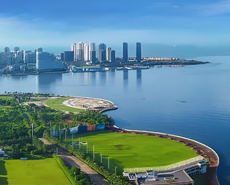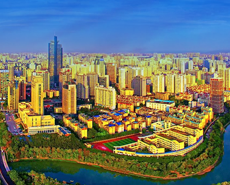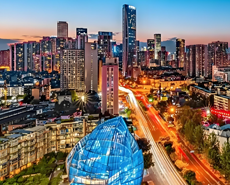Silicomanganese prices still on the upward trend in short term
----Interview with Wei Senzang, Vice Sales Manager of Bisheng Mining
Baise Bisheng Mining Co., Ltd. was established in August 2008 based on registered capital of RMB106 million with a coverage of more than 200 acres. With advanced production and quality inspection equipment and professional staff, the company has been in long-term cooperation with large state-owned enterprises including Shanghai Baosteel, Fujian Sangang, Guangdong Shaogang, Valin Lian Steel, Liusteel, Yunnan KISC, etc.
Asian Metal: Hello Mr. Wei, could you please make an introduction to your company?
As a large production enterprise, Baise Bisheng Mining Co., Ltd. is engaged of production and sales of silicomanganese alloy with four submerged arc furnaces of 25000KVA and two sets of independent power system to ensure of stable and advantageous power supply to production. With designed capacity of manganese alloys for 200,000tpy, the company has been obtained the seventh batch of industrial access permission and ISO9002 quality certification. With advantages in convenient transportation and unique location, the company is no more than 2km from the entrances of Guangzhou-Kunming Highway, Shantou-Kunming Highway and cargo terminal of Baise eastern train station and no more than 1km from the the national road of 324 and 323. The company also owns independent inland water transport with capacity of 1,000t of shipment; the company is 200km far from Qinzhou port. Based on the development philosophy and purpose of "green environmental, quality product, people first and win-win cooperation”. The company welcomes all steel plants and people from all walks of life to visit the company and supervise the work.
Asian Metal: What’s your opinion on the surging silicomanganese prices in H2 2016 and how to explain this increase?
The surging silicomanganese prices were mainly resulted from rising prices for raw materials of imported manganese ores, coke, etc. and the transportation cost of road, railway and water has also increased. Prices for Australia-origin ore 46-47% surged by RMB20/dmtu (USD2.90/dmtu) in early 2016 to RMB88/dmtu (USD12.77/dmtu) in late November, up by as high as 340%, leading to higher production cost. Bidding prices for December from steel mills have reached the higher range of nearly RMB9,200/t (USD1,335/t) D/A delivered and thus the surging price is the major trigger of higher silicomanganese prices. Meanwhile, suppliers might jointly raise prices, which may be another factor. In addition, coke prices also pushed up silicomanganese prices and suppliers continued to raise silicomanganese prices due to higher production cost.
Asian Metal: What are the major reasons behind slumping silicomanganese prices during January to February 2017?
The main reasons are as follows: 1. Imported manganese ore stocks were at high level in the market after the New Year and the imports of 1.9 million tons by China in January have been on arrival gradually. Thus, stocks were stockpiled. The cost was in disparity due to decreasing manganese ore prices with hand-to-mouth purchases from downstream consumers and continuously sluggish deals in the market. Meanwhile, most producers held stocks purchased at higher prices and had to lower prices for silicomanganese as downstream steel plants continued to press down prices. 2. Steel plants held large stocks before the year. Most steel plants directly rebuilt stocks for consumption of two months in view of the Spring Festival holiday. As a result, the demand in the silicomanganese market cooled down rapidly after the year and suppliers competed fiercely in order to promote sales, leading to decreasing prices for the material.
Asian Metal: What do you think of the silicomanganese market in Q2? Will the market see soaring prices?
Silicomanganese prices may increase in Q2 and the supply and demand will be more balanced with steady increase in price. The price slumped early this year and some producers have seen production cost in disparity of RMB1,000/t (USD145/t). In order to shake off losses, producers intended to jointly raise prices and the future market may move on the upward trend as a result. Impacted by environmental inspection, the demand from end steel plants saw no rapid increases and thus silicomanganese price increase will be more moderate. Actually, the market could only see limited deals except for impacts of human factors and thus participants should take rational attitude towards the market.
Asian Metal: What’s your actions in production and sales in response to slumping prices early this year?
As prices even slumped to below the normal production cost, we reduced productions or started maintenance on furnaces purposely. We have suspended productions of two of out four submerged arc furnaces at present, which may be full resumed in May.
Asian Metal: Overseas prices for raw material manganese ore (such as BHP Comilog Vale OM, etc.) continued to slip. What impacts will be imposed on spot manganese ore and silicomanganese in your opinion?
Consumers are in low acceptance of bulk purchases of manganese ore and steel plants will press down prices for silicomanganese. In view of low prices, producers will be inactive in production as well, which will result in low inventory for the material. Offers for BHP Comilog Vale OM continue to move downwards, which have slipped to USD7.0/mtu in February and USD4.5/mtu in March from the price of USD9.5/mtu in January. As a result, manganese ore consumers are cautious to make purchases of futures and only maintain inventory at low level instead of bulk purchases.
Asian Metal: How is the operating rate in South China at present?
Producers in South China are facing up silicomanganese prices higher than the production cost at present and thus operating rate is maintained at low level. Only a few producers are in production and those in operation cut output sharply.
Asian Metal: Compared with producers in Inner Mongolia and Ningxia, what are your strengths and weaknesses?
As for advantages, we are in advantageous position in location, ports, transportation cost and facilities, climate, natural conditions, etc. compared with steel plants in South China. We are much closer to Qinzhou port and thus the transportation cost is much lower. However, Ningxia and Inner Mongolia, the major production regions, are far away from Tianjin port and therefore the production cost is much higher.
As for disadvantages, the electricity cost is much higher, which is RMB0.5/kwh (USD0.07/kwh) in South China and RMB0.4/kwh (USD0.06/kwh) in North China. The electricity cost is higher by RMB400/t (USD58.12/t) by rough estimation.
Asian Metal: Thank you very much for this interview.
















